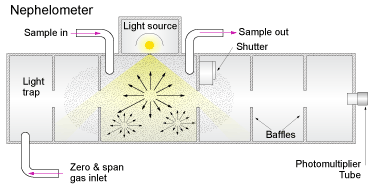Measuring visibility
Aerosols and fine air particles, such as smoke or haze, can reduce visibility. Aerosol monitoring measures this loss of visibility.
Light is scattered by airborne particles and this forms the basis for measuring aerosols using an instrument called a nephelometer.
Nephelometer

A nephelometer (View larger version)
Inside the instrument, a light source sits in a matt black tube containing ‘baffles’ to minimise reflected light.
The detector (a photomultiplier tube) is located so that it measures light at right angles to the axis of the beam, to avoid any direct (un-scattered) light from the source.
Any particles in the air sample will scatter some light towards the detector, which measures, amplifies and converts the signal into a light-scattering coefficient (a measure of the amount of scattering).
This coefficient corresponds to the concentration of particles in the sample and provides an estimate of visibility. The instrument is particularly sensitive to small smoke particles, common during bushfires.
Gases in the atmosphere affect the scattering of light through absorption, although at normal outdoor concentrations this is negligible. However, calibration of the nephelometer uses this principle by filling the instrument with specific gases at very high concentrations.
Current levels
View the live air data service to check the current levels of visibility-reducing particles (aerosols) in the monitoring network.


